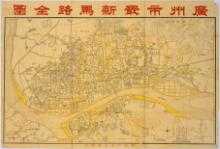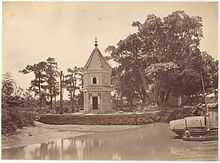Litchi Bay
Litchi Bay (simplified Chinese: 荔枝湾; traditional Chinese: 荔枝灣; pinyin: lìzhīwān) or Lizhiwan, is a famous tourist attraction in Guangzhou, Guangdong Province. It is famous because of its long history and culture. There are many historical relics and historical architectures in Litchi Bay, such as Wenta and Xiguan House. What's more, there are many traditional foods. Nowadays, many cultural activities would be held on Litchi Bay, such as the competition of Cantonese opera. It can be said that Litchi Bay is one of the birthplaces of Guangzhou culture.
Geography
Litchi Bay is located in Liwan District(荔湾区), Guangzhou city. It is drainage system which comes from Zhujiang. There are new Litchi Bay and old Litchi Bay. Old Litchi Bay was near Caihong Road, which was smaller. New Litchi Bay contains Pun Tong (泮塘) and its surroundings. Nowadays, "Litchi Bay" always means new Litchi Bay.
History
The origin of Litchi Bay
Litchi Bay's history can go back to 2200 years ago. In 206 BC, Han emperor asked his subordinate, Lu Jia to come to Guangzhou for surrendering. After that, Lu Jia settled down in Xicun, a little village in Guangzhou. Then, he began to plant vegetables and flowers. Gradually, people started to call this place "Litchi Bay". And, it became famous and got the reputation of "Little Qinhuai"(小秦淮).
The rise of Litchi Bay
In Tang dynasty, people started to build the famous garden "Liyuan"(荔园). In Nanhan dynasty, there has been many gardens like "Fanghuayuan"(芳华苑), "Hualinyuan"(华林园) and "Changhuayuan"(昌华苑). And, it became imperial garden. In Yuan dynasty, there has been lemon gardens. In Ming dynasty, Litchi Bay became a tourist attraction for ordinary people. Besides, it became one of the eight most famous attractions in Guangzhou. In Qing dynasty, Litchi Bay became more famous.[1]

The decay of Litchi Bay
In 1940s, Litchi Bay became a habitation for vegetable growers and poor people because of the rapid development of urbanization in Guangzhou city. In order to expand the city area and build more houses, the citizens cut the trees down. At the same time, Xicun became the industrial base of Guangzhou city. It polluted the river, and the water quality got worse and worse.
The disappearance of Litchi Bay
In 1950s, there were still water channels, but every branch of these water channels was filled with earth. With the establishment of factories in Guangzhou, the water system of Litchi Bay had become a cesspool. In 1980s, more and more water channels were filled. In 1992, the last water channel—from Panxijiujia(泮溪酒家) to Fengyuanqiao(逢源桥) was filled. Litchi Bay disappeared.
The reappearance of Litchi Bay
In 1999, the Chinese People's Political Consultative Conference raised a proposal about rebuilding Litchi Bay. In 2009, this proposal was finally put into effect because of the Asian Games. On October 16, 2010, water was imported into the river, Litchi Bay had a new born.
Tourist attractions
Liangjiaci
Liangjiaci(梁家祠)is on NO.34, Liangjiaci Street, Liwan District, Guangzhou City. This architecture is orientated north and south,which is filled with Lingnan flavor.[2]

Xiguan House
Xiguan House(西关大屋) can be represented the traditional culture of Guangzhou. This architecture was first appeared in Qing dynasty, which was for the rich and powerful people. Nowadays, most of them are used for tourism. However, some of them are still used for people to live. There are three features about Xiguan House, brick-wood structure, Tanglong door and Manzhou window.
Renwei Temple
Located in Longjingxi Road, Guangzhou, Renwei Temple(仁威庙) is about 2200 square meters. This temple is specially used for worshiping Zhenwu Emperor (真武帝) and Taoism. Renwei Temple was built in 1052. It is also famous for its decorations, such as wood carving,stone carving and brick carving.[3]

Wenta
Wenta(文塔)is also called Wenbita(文笔塔), Wenchangta(文昌塔),it is located in Litchi Bay. No one knows when did it being built. However, according to its architecture style, it was built in Qing dynasty. Wenta is brick-wood structure,and it is 13 meters high with 2 floors.[4]
Cruise ship
People can take electric ships to visit around Litchi Bay.
The price of tickets. Child: 50 RMB. Adult: 100 RMB. Older: 75 RMB.
This kind of cruise ships concludes visiting around Litchi Bay by ship, feeling the flavor of Xiguan and explanation from the guide. This tour is around 50 minutes.
Food
There are many Lingnan foods in Litchi Bay. A lot of people go there and taste traditional Guangzhou food.
Beef offal
Beef offal is famous in Guangzhou. It is not only made by beef, it also has radishes and Chinese medicines. There are many flavours of beef offal, and in Guangzhou, beef offal is salty and spicy. Beef offal has protein which is good for health. However, people should not eat too much at one time.[5] In Litchi Bay, many people would cup a bowl of beef offal.
Water chestnut cake
Water chestnut cake is one of the traditional desserts in Guangdong province and south Fujian, which is canary yellow, translucent and good taste. There are many kinds of water chestnut cake, such as coconut-water chestnut cake and hawthorn-water chestnut cake.
Pickled radish
Pickle radish tastes sweet and sour, which is appetizing food. In China, most people think that pickled radish should be with pepper because it can make it has more flavor. However, in Litchi Bay, no one put pepper into pickle radish.
References
- ↑ The history of Litchi Bay Retrieved Nov 27,2014.
- ↑ Liangjiaci.梁家祠百度百科. Retrieved Nov 27,2014.
- ↑ Renwei Temple.仁威庙旅游介绍. Retrieved Nov 27,2014.
- ↑ The introduction of Wenta.文塔旅游介绍. Retrieved Nov 27,2014.
- ↑ The nutritive value of beef offal.牛肉营养价值. Retrieved Nov 27,2014.
External links
- 搜狗百科 in Chinese.
- Litchi Bay Tourism Network in Chinese.
Coordinates: 23°7′19.13″N 113°13′46.65″E / 23.1219806°N 113.2296250°E